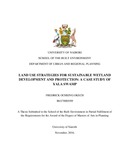| dc.description.abstract | Kenya has a wealth of wetland ecosystems that support diverse and unique habitats. These wetlands provide numerous ecological goods and services but are under tremendous stress due to rapid urbanization, industrialization and agricultural intensification; manifested by the shrinkage in their areal extent, and decline in the hydrological, economic and ecological functions they perform. Yala swamp, the largest fresh water wetland in Kenya measuring about 17,500 ha supports a large biodiversity and is a source of livelihoods to communities around it. The aim of this study was to establish the current utilization of the wetland, the effects of the utilization on conservation and to explore sustainable land use strategies for deployment at Yala Swamp to safeguard it from negative impacts of development and associated human activities. Data and information were obtained from primary and secondary sources through field survey in the Yala Swamp wetland, in which 90 households drawn from two locations bordering the swamp in Bondo and Siaya sub-counties were interviewed. Interviews were also administered to local community leaders, selected key informants in the Siaya County Government and Kenya Wildlife Service as well as officers from Dominion Farms. The research instruments included questionnaires, Key Informant Interviews (KII), direct observation and, lastly, Focus Group Discussion (FGD) with two groups representing the two aforementioned counties. From the study, it is evident that Yala Swamp is the primary source of livelihood to the surrounding communities. They rely on it for a variety of ecosystem services such as fish harvesting, farming, papyrus extraction for mat making, livestock grazing amongst others. However, evidence on the ground such as land degradation, water pollution, encroachment and attendant conflicts shows clearly that continuous unplanned utilization of the wetlands‘ resources is a great and present threat to the existence of the fragile ecosystem. The study suggests a raft of land use strategies to bring order in access and utilization of the resource which in turn should ease the current pressure. These include development of land use plan whose outcome would be zoning of land for specific uses, regulation of intensity of use, formulation of legal and administrative instruments to support the plan; completion of survey of the swamp to define boundaries with the surrounding community and stem encroachment; compulsory acquisition of surrounding lands to create a buffer around the swamp; land exchange programme in which less ecologically sensitive parcels elsewhere are exchanged with private land near the swamp; and finally, the government through Kenya Wildlife Service to re-examine the process that led to the gazettment of a section of the swamp and come to a common understanding with the community. | en_US |

